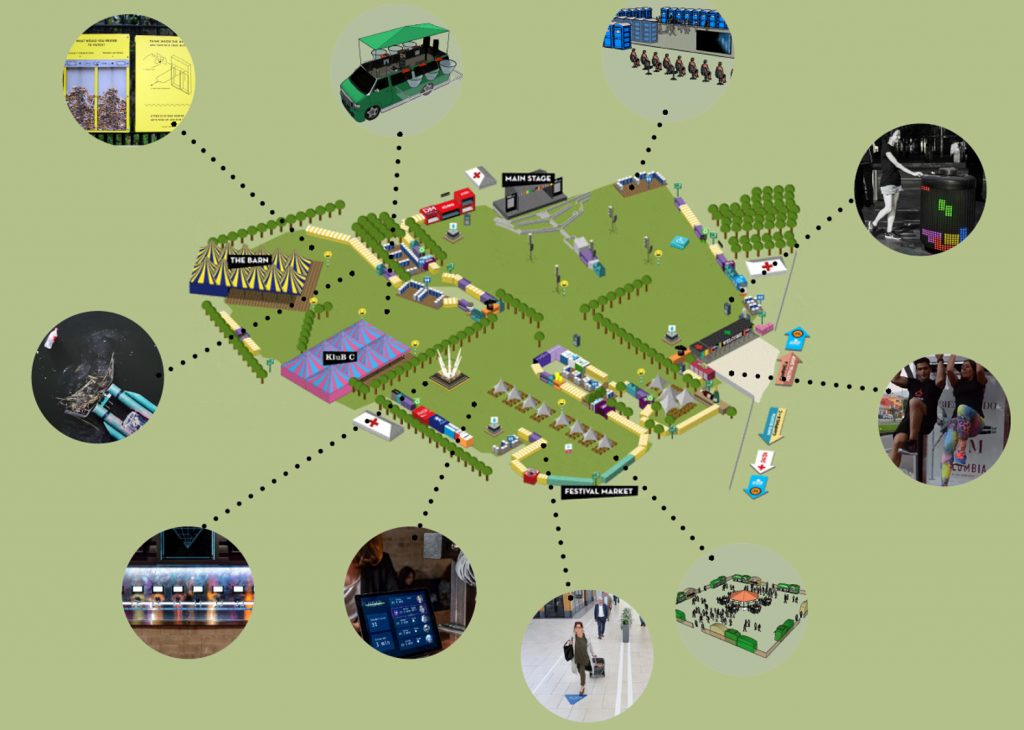Experience design for future festivals: two theses
September 16th, 2020How can visitor experiences at music festivals be optimized? Commissioned by POPLIVE two students dedicated their bachelor thesis to this topic, respectively focusing on innovative solutions for on-site festival challenges and crowd behavior at different types of festivals. In this blog post the results of these projects will be presented.
As previous research from the POPLIVE team has shown, music festivals are sources for multiple value creation. Nevertheless, festival organizations still face several future challenges, of which surviving the Covid-19 pandemic is obviously the most urgent and significant. Other challenges include reducing nuisance and pollution and optimizing the festival visitor’s experience. After two decades of exponential growth, the festival industry now needs to focus on creating a sustainable future. On the eve of the global Covid-outbreak, two Leisure & Event Management students from Rotterdam University of Applied Sciences decided to dive into this topic in the context of their bachelor thesis. From a visitor experience design perspective, they gained insights and developed tools for festival organizers to enhance their festival experience. Rens Idzenga applied the cross-industry innovation approach to mitigate some of the most relevant visitor pains, related to visitor queues and visitor waste disposal during the festival; Jens Wijntjes focused on the difference in visitor experience between festival shows with music played live on stage (e.g. bands, singers) and shows with (mainly) pre-produced music (e.g. dj’s, producers). Both projects will be explained below.
Cross-industry Innovation at Music Festivals – Rens idzenga
The goal of this project was to maintain and enhance the experience value of music festivals. In developing festival visitor experiences, innovation is regularly extracted from within the industry. However, in this study other sectors and industries were used as a source for innovation. Cross-industry innovation (CII) is “a clever way to jump-start your innovation efforts by drawing analogies and transferring approaches between contexts, beyond the borders of your own industry, sector, area or domain.” (Vullings & Heleven, 2015). Before applying this method, two main challenges in relation to the festival site were extracted from interviews with Dutch music festival organizers: waste disposal and visitor queues. Idzenga: “With these two challenges as a starting point I have applied the CII approach. Trend research and expert interviews helped me to develop ten specific experience design solutions for both challenges. For example, gamification can be applied to make waste disposal a fun experience and augmented reality can be applied to add a virtual experience for people queuing up during the festival, reducing the experienced waiting time.” The range of proposed innovations include a mobile waste disposal music stage, arcade-game garbage bins, waiting line relax chairs and artificial intelligence applications. Concluding, a broad range of solutions for festival challenges can be found in other sectors and industries, even though these might have different business models, different goals and different customers. These cross-industry innovations offer promising solutions to music festival challenges. Idzenga: “So festival organizers and producers, do look further than your own industry and be inspired by existing solutions in other industries to solve your problems and innovate your music festivals!”
The inspirational toolkit for cross-industry innovations at music festivals by Rens Idzenga can be found here (in Dutch).

Visitor behavior at live vs. non-live festival shows – Jens Wijntjes
The driving force for every festival organizer or producer is to bring people together to experience collective euphoria. At the same time the festival visitors join the experience to express themselves and have a memorable time with like-minded people. Yet, the motivations for visiting festival and the experiences gained during the festival are strongly related. The aim of this research project was to relate and compare visitor motivations, behavior and experiences to two different types of music festival supply: live-played music (artist who play and sing live on stage) and pre-produced music (where (most of) the music is not played live on stage). A combination of qualitative and quantitative research showed that the visitor’s behavior and experience significantly differs for both types of music on stage: visitor behavior during live-played music festivals can be characterized as very pulsive: they generally show a relatively great dedication to the artist on stage and behave accordingly. In the context of crowd management, this leads to peak visits; during the show around the stage and before and after the show around other facilities at the festival site. These peak moments create challenges for festival producers, not only in relation to crowd control but also in relation to the allocation of bar staff. This pulsive behavior potentially creates negative visitor experiences and demands continuous attention from the production staff. Research on (predominantly) pre-produced music festivals draws a different picture: here, visitor behavior is much less pulsive and better defined as smooth, with more or less continuous crowd flows during the festival. Wijntjes: “The outcomes of this comparative research can be very valuable to festival organizers and producers. I would advice music festivals to continuously register and map the behavior of the visitors and act accordingly. In doing so, festivals can annually improve the visitor experience and relieve what is probably the most negative touch point in festival visitor experiences: waiting lines and overcrowded areas.”
Jens Wijntjes produced a video report to present his research findings, which can be found here (in Dutch).
For more information about these projects please contact Martijn Mulder
